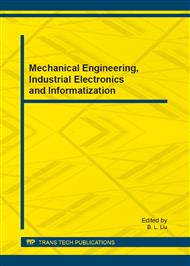p.93
p.97
p.102
p.106
p.113
p.117
p.121
p.125
p.130
An Improved Algorithm of Linearization Localization Based on RSSI Ranging
Abstract:
The positioning technology has become one of the most popular studied objects since it has been implemented in many fields. With five reference nodes at least, linearization localization algorithm get an acceptable accuracy. With Taylor Series Expansion, we can overcome this shortcoming. First, we give the blind node an initial coordinate, then we expand the group of binary quadratic based on RSSI with Taylor Series at the point of initial coordinate, remove quadratic and higher, at last ,we apply iteration algorithm to estimate the real coordinate of blind node. Compared to the original, this new method can get a very good accuracy with only three reference nodes.
Info:
Periodical:
Pages:
113-116
Citation:
Online since:
February 2013
Keywords:
Price:
Сopyright:
© 2013 Trans Tech Publications Ltd. All Rights Reserved
Share:
Citation:


